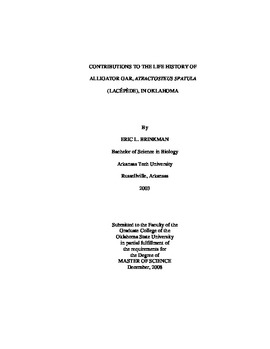| dc.contributor.advisor | Fisher, William L. | |
| dc.contributor.author | Brinkman, Eric L. | |
| dc.date.accessioned | 2014-04-17T20:13:16Z | |
| dc.date.available | 2014-04-17T20:13:16Z | |
| dc.date.issued | 2008-12-01 | |
| dc.identifier.uri | https://hdl.handle.net/11244/10321 | |
| dc.description.abstract | Alligator gar populations are declining in the southeastern United States and Mexico resulting in efforts by state and federal agencies to actively manage populations. We assessed the life history of the alligator gar population in the Red River drainage of Oklahoma. We estimated relative population abundance using an adaptive stratified random sampling design. Movements and home-range were examined using ultrasonic telemetry. We assessed the accuracy and structural biases of sectioned scales for determining age and growth of alligator gar. Scale sections were aged by three readers, and a subsample of these determinations were compared to whole otolith ages, determined by an expert reader. We compared reproductive behavior of alligator gar spawning, observed in 2007, to other recent spawning events in the southeastern United States. Catch rates for larger alligator gar were highest using multi-filament trammel nets during cold water periods, whereas mini-fyke nets were effective for collecting young alligator gar in warm water periods. Alligator gar exhibited logistic growth devoting early growth to increasing length and later growth towards increasing mass. Home range area of six individuals ranged from 4.93 to 17.13 km2 during a nine month period. Linear home range of these individuals ranged from 5.77 to 49.72 km. Ages of 64 alligator gar ranged from 0 to 28 years at date of capture. Age data indicated that successful spawning occurred in 2006 and 2007, and spawning in Lake Texoma was documented in spring 2007. Age determination of alligator gar, using scale sections proved to be imprecise and biased towards overestimation of age in adults. The alligator gar population in Lake Texoma and the Red River above the reservoir, was represented by a range of age and length classes. Future stability of Red River alligator gar populations will be dependent on availability of shallow, flooded herbaceous vegetation and proper management of exploitation. | |
| dc.format | application/pdf | |
| dc.language | en_US | |
| dc.publisher | Oklahoma State University | |
| dc.rights | Copyright is held by the author who has granted the Oklahoma State University Library the non-exclusive right to share this material in its institutional repository. Contact Digital Library Services at lib-dls@okstate.edu or 405-744-9161 for the permission policy on the use, reproduction or distribution of this material. | |
| dc.title | Contributions to the Life History of Alligator Gar, Atractosteus Spatula (Lacpde), in Oklahoma | |
| dc.type | text | |
| dc.contributor.committeeMember | Echelle, Anthony A. | |
| dc.contributor.committeeMember | Shoup, Daniel E. | |
| osu.filename | Brinkman_okstate_0664M_10124.pdf | |
| osu.college | Agricultural Sciences and Natural Resources | |
| osu.accesstype | Open Access | |
| dc.description.department | Wildlife Ecology | |
| dc.type.genre | Thesis | |
